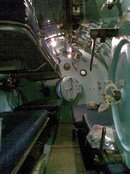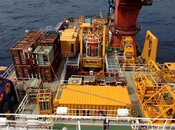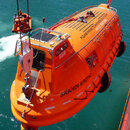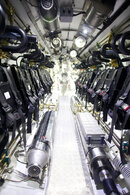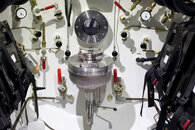All things considered, I would prefer to have a hyperbaric lifeboat onboard than not. But I dont know many divers that put much faith in them.
Consider that most bells are in the water ~22/day. Larger purpose-built diving support vessels have two bells and a 24-man crew in saturation. Two working crews may be at different depths and 4-8 are decompressing out for a crew change. So lets say you have a crew at 50' with ~16 hours of decompression left. Another working crew at 300' and another at 600'.
Now picture both bells on the bottom with a tender in each and a diver locked out. The ship suffers server damage and lists to 30°. The diving supervisor orders divers back to the bells and starts blowing the two shallow crews down to 600'. He considers blowing them all down about 50' deeper than the bottom in case she sinks and they need to try a rescue from the wreck. At least they wouldnt drown before hitting the bottom. He hopes like hell he can recover the bells at that list angle in a heavy sea.
Meanwhile, shipping containers, gas tube trailers, and working loads start breaking loose from their lashings and slide around the deck. Hopefully they fall overboard before destroying lifeboats, launch gear, banks of HP oxygen 12-packs, or one of the bells. A pressurized bell or 3000 PSI tube trailer exploding would take out the entire vessel and do serious damage to any platform they may be next to.
Both bells are recovered and mated. The deep crew starts manning the hyperbaric lifeboat waiting for the shallower and bell crews to arrive. The crew from 50' is suffering severe compression pains and bordering on hyperthermia due to heat of compression (Helium is much worse). Everybody is finally in the hyperbaric lifeboat and the hatches are sealed. The diving support crew vents pressure in the transfer trunk, opens the mating clamps, and the lifeboat can be unmated. At this point several diving support crew climb aboard the lifeboat, get launched into the sea, and motor off until they can be recovered by another suitably equipped diving support ship. Of course this is assuming the list doesn't prevent launching. If not, the lifeboat crew will risk their lives and hope they survive the ship sinking under them.
Say there is a rescue ship within 100 miles but she has a smaller system that supports 12 and are in sat at 800. They also have a crew decompressing in another set of chambers who are at 150'. The rescuing diving super debates whether to blow them down to 800' because they will need the space and scrubber capacity or keep bringing them up. The only option is to press the lifeboat down 200' more and welcome them aboard. The rescue ship will have to launch their hyperbaric lifeboat in order for the rescued boat to mate. It is crowded, environmental control systems are designed for 12 divers, but the lifeboat augments. They all reach the surface about 10 days later unless they can find a second rescue ship to share the load.
I wouldnt be too critical if a hyperbaric lifeboat wasnt onboard this vessel. You can Google Hyperbaric Lifeboat and see lots of photos and drawings. Perhaps this will help you appreciate my dismissive attitude towards hyperbaric lifeboats. The reality is it would be a miracle if most of the topside crew could be saved. We all wish we could do something when things like this happen. Your thoughts are in the right place.



